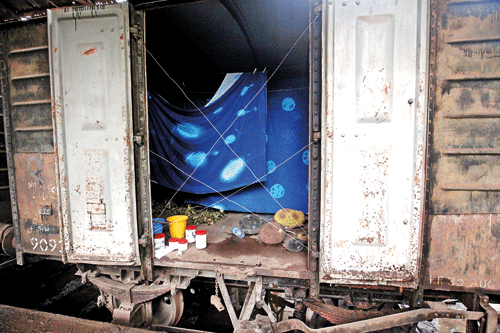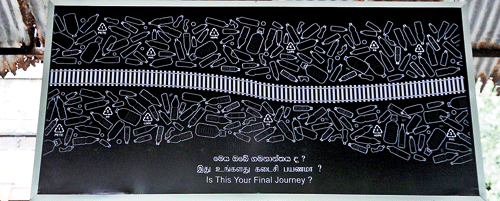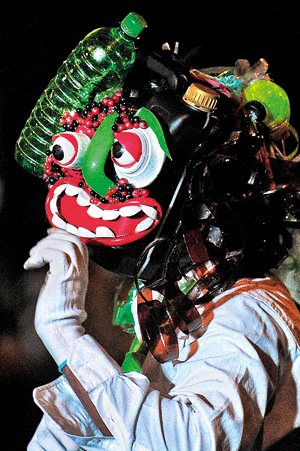All aboard: Art and environment

Art in unlikely places. Pix by Priyantha Wickramaarachchi
In the heart of Maradana lies an old building with a dilapidated railway platform, disused train carriages and overgrown tracks adjoining it. Relics of a bygone era, the building is the forgotten former Railway terminus, which acted as the central railway station of Colombo until the Fort station and the south line were built. But life seeped into this empty space once more last week when the fifth annual Cinnamon Colomboscope art festival unfolded here from September 2 to 7.
A multi-disciplinary contemporary art festival, Colomboscope is no stranger to the use of unconventional venues. Founded and conceptualized by EUNIC Sri Lanka, it had previously been held in the disused Rio hotel and General Post Office buildings in Colombo.

Our plastic: An artist’s perception of where we are heading at the station’s signboard
This year’s festival titled Re/Evolution, had the global environmental crisis as its central theme with artistes, environmentalists, economists and historians exploring the theme through exhibits, films, musical performances, workshops and talks. Overall the festival was content heavy and eclectic in its showcases.
However, the footfall though reported to be on par with previous editions, was not as high as expected aside from

Confronting a current evils: A mask of frightening reality, part of the Sanni Project. Pic by Amila Gamage
the weekend. The rain probably was a factor, but several visitors said the venue being relatively unknown and difficult to locate contributed to lower turnout.
Perceptions of elitism also seemed to dog the festival as some visitors pointed out the lack of information disseminated in the Sinhala or Tamil media. “Api methanata awe api methana wada karana hinda habai anith aya meka gana danne wath naha (we came here because we work here but others don’t even know about this),” Railway protection service officer Ananda Samaraweera said, adding that if the information on the artists and the exhibits were available trilingually, that would also improve the quality of the event.

A new look at old buildings. Pic by M.A. Pushpa Kumara
Yet the background of the forgotten Railway terminus seemed a perfect juxtaposition for the message of sustainable and environmentally conscious development the event wished to send, showcasing the ugly side of rapid yet unsustainable industrial development and why we as a society need to take into account the environment in our march towards development.
Colomboscope which prides itself on providing a platform for contemporary art saw the inclusion of many emerging artists at this year’s exhibition, a decision which Curator Menika van der Poorten, feels has paid off as a
whole. “I sometimes selected artists who did not have a body of work based on the merits of their portfolio,” she said, adding that she is happy with her decision.
Organized by Cinnamon Hotels and Resorts together with the John Keells Foundation, the event by and large avoided the confusion that plagues most artistic festivals. Spaces were well assigned, programmes took place on time, and artists were in line with the theme, which helped strengthen the message of the festival. Overall the festival was thought provoking and facilitated the discussion of solutions to our present environmental crisis in a way only art could do.
| Shifting Spaces | |
| The Global Shapers of Colombo presented several technical and artistic collaborative performances ‘Shifting spaces’ on the fifth day of the festival exploring the issue of waste management.The session began with a narration of Colombo’s past as a node in the British Empire’s trading network and how it led to rapid urbanization of the city by Ramla Wahab aided by Dhanouk Goonewardena’s graphic illustrations.The next performance, ‘Junk Journeys’ showed that Colombo’s waste crisis is also rooted in the apathy of the public. A collaboration between environmental scientist Shayani Weeresinghe, journalist Raisa Wickrematunge and artist Minal Wickrematunge, the video explored this issue in relation to the Meethotamulla tragedy. Economist Chantal Sirisena’s and actor Biman Wimalaratne’s performance – a comical skit caricatured the workings of a government department. The duo explained how the use of the Right to Information Act by the public can facilitate good governance and promote better planning and effective execution with regard to solid waste management. The final performance saw Shayani Weeresinghe appealing to the audience to rethink their approach to waste, advocating the use of baled plastic (recycled plastic) for the creation of new products, ending on a note which was essentially a call to action. |
| Curated walk | |
| By Shakya Wickramanayake Not only the venue but the locality: Ethnographer and art historian, Ganga Rajinee Dissanayake led a curated walk on September 5 covering sites such as the Technical College, the Maradana Railway Station, Police Station, Zahira College, Vidyodaya Pirivena and Mahabodhi Viharaya among others. Dissanayake delivered a comprehensive history of the rise and fall of Maradana, beginning with how it developed due to the migrant communities from South Asia including Parsi traders and Malayali cooks who came in search of trade and employment during colonial times. With the construction of the railway to bring in coffee from the plantations of Warakapola, the area soon developed with new infrastructure such as the railway station and police station, (the first police station and headquarters to be established in Colombo) bringing in trade, commerce and people to the area. Maradana saw the birth of the printing, furniture auction and framing industries in the country, she said, evidenced by buildings such as the Globe Furnishing House and the Epa Printers. Signs of its former diverse trade community still linger with establishments such as Hongkong Textile Ceylon, the Chinese Union Store and the Bombay Sweet House. The walk ended at the Vidyodaya Pirivena and Mahabodhi Viharaya, which flourished under the patronage of wealthy Buddhist traders in the area, going on to greatly impact Buddhist education in the island, becoming the epicentre of the Buddhist revivalist movement. The Citizenship Act, race riots and bomb blasts during the recent conflict contributed to Maradana’s decline and led to it being isolated from the development that propelled the rest of the city. But looking back at its past, the participants now had a greater appreciation of the area.
|
| Talking Graphene | |
| By Sinali Ranwala Aiming to inspire a dialogue on sustainable living, senior scientist and head of strategic planning at the Sri Lanka Institute of Nano Technology Dr. Shehan de Silva explained the potential uses of Graphene, a form of carbon at ‘Building Green Tech’ – a panel discussion at the festival. “Graphene is earmarked to be a wonder material because it’s carbon-based and cheap. Its properties are brilliant in terms of thermal,conducting mechanical properties etc.,” he said. Dr. de Silva feels that there needs to be greater public awareness about renewable energy. “We need a modern day Mahaveli, in order to gain energy independence. A drive similar to the drive America had to achieve the moon race. Can we put this as our goal for 2030? Longer term strategies that outlasts governments are needed,” he said.
|
| Multidisciplinary exhibition | |
| By Kaveesha Fernando The multidisciplinary art exhibition on display from September 2 -7 featured many interesting pieces. Here are a few of the exhibits and projects: Tree photos Indian artist Surekha’s work featured photos of large banyan (nuga) trees and women of the community whose lives were influenced by the trees. It also highlighted the Chipko movement in India that began when around 300 Bishnois (an Indian religious sect) decided to protest the felling of trees to create a palace in colonial India by hugging them, resulting in their beheadings. The movement is also the origin of the phrase ‘tree hugger’. Ayurveda photos Kesara Ratnavibushana’s photographs focused on household plants which can be used for ayurvedic purposes, enlarging them so that people could appreciate the minute details of the leaves.“I’m often amused at the people’s sense of wonderment at which plant is which and many people mistake the lime leaf for something else, which is also interesting,” Ratnavibushana said. The Pin Thaliya This exhibit consisted of a clay pot (representing the pin thaliya) surrounded by plastic bottles which had messages on them, explaining how much destruction the bottled water industry has on the environment. The pin thaliya filled with drinking water was left outside each Sri Lankan house in the past. “E dawas wala ewata gewanna wath wune naha. Dan api me plastic bothal walata gewala parisarayath winasha karanawa (We did not have to pay for the water in the pin thaliya in the olden days. Now we have to pay and we destroy the environment also in the process,” commented Nadika Siri, an employee of the Railway Stores Department. The Sanni Project Inspired by the traditional sanni yakuma or ‘daha-ata sanniya’ exorcism ritual, the artists highlighted six modern issues such as the use of pesticides, deforestation and sound pollution, through masks. A dance performance brought the issues to life even further through the costumes, which were built around the mask, as well as with the music and verses sung in Sinhala – a modern day sanni yakkuma of sorts. “We wanted to portray the evils within us using exorcism rituals,” explained the artist.
|


